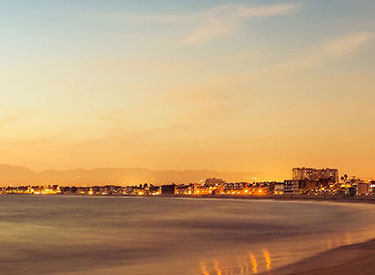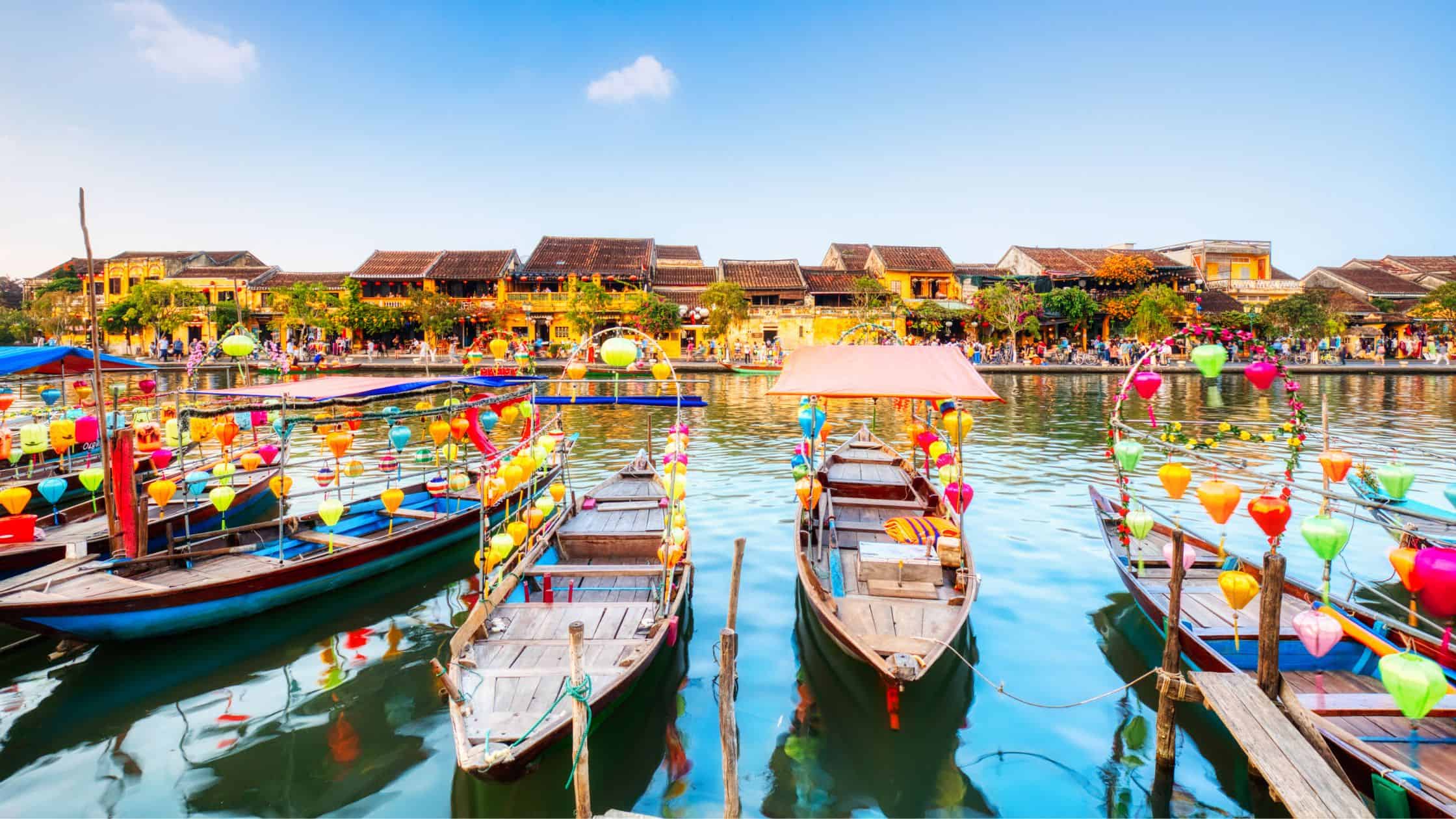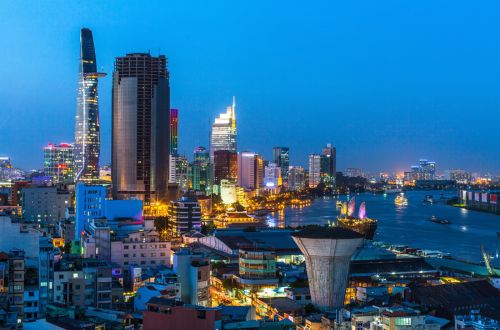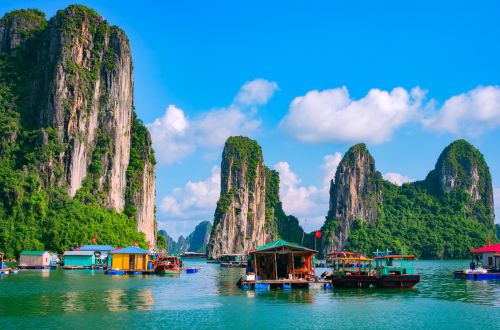


With its delicious cuisine, astonishing landscapes and vibrant culture, Vietnam is a bucket-list destination for many travellers. Our handy Vietnam holiday guide is packed with handy tips and travel advice, from where to find the best street food to our favourite things to see and do in this incredible Southeast Asian country:
The Socialist Republic of Vietnam, as it is formally known, is located in Southeast Asia and shares borders with China, Laos and Cambodia. It’s home to almost 100 million people, the vast majority of whom speak the national language, Vietnamese. The capital city is Hanoi.
Measuring approximately 1650 kilometres from north to south, and rising from sea level to a mountainous interior, Vietnam’s weather varies widely across its different regions. The northern region experiences four distinct seasons, with cold winters and hot summers. In the south, the weather remains relatively warm all year, with distinct dry and rainy seasons. Spring (March and April) is typically the most popular time of year to visit when you can expect to enjoy sunny days and warm temperatures throughout the country. From May to November, the rainy season brings frequent tropical downpours (especially in southern Vietnam) which make for spectacular conditions if you are a photography enthusiast.
A direct flight from Sydney or Melbourne to Ho Chi Minh City takes around nine hours, or you can fly via another Asian gateway such as Singapore or Bangkok. From there, it’s a further two-hour flight to reach the city of Hanoi, which is the main gateway to northern Vietnam. The 36-hour train journey from Hanoi to Ho Chi Minh City on the Reunification Express is a wonderful way to see the countryside close-up. Open-tour sleeper buses are another popular public transport option for long distance travel between key Vietnam tourist places.
Once you’re on the ground, your options for getting around are as diverse as the country itself, and will depend on your budget, how much time you have and how independent you want to be. Taxis and tuk tuks are a thrilling way to get around the cities, especially if you don’t want to navigate the often-hectic traffic on your own. To explore the countryside at a more leisurely pace, you can opt for a bicycle or take a ride through the rice fields on a buffalo cart.
There’s a wide range of accommodation options to choose from in Vietnam, from historic hotels like Hanoi’s legendary Sofitel Legend Metropole Hanoi to the luxury beach resorts that line the white sands of Da Nang, the tranquillity of an ecolodge in the heart of the Central Highlands, or indulgence of a spa retreat in the northern hill country near Sapa.

A visit to the War Remnants Museum is a must if you want to learn about the city’s role in the Vietnam War, ideally followed by a tour of the infamous Cu Chi Tunnels.


Hoi An has a long history as a centre for silk and garment making, and today remains one of the best places to buy beautifully tailored clothing. Spend a day at the nearby coastal town of Da Nang to enjoy another of Vietnam’s most spectacular beaches. The incredible Golden Bridge is located an hour’s drive from Hoi An in the picturesque Ba Na Hills.
You can tour the sections of the cave systems by boat or on foot with experienced guides, but be aware that many areas are only accessible during the dry season months (November to April). You can also go rock climbing and hiking among the towering limestone peaks, go river kayaking on secluded waterways, and visit the stilt houses of the ethnic Bru Van Kieu people.


Vietnam is a fantastic destination to experience with kids of all ages, offering a blend of cultural exploration, outdoor adventures and fun activities. Vibrant cities like Hanoi and Ho Chi Minh City are fun to explore, with bustling markets, entertaining street performances and unique cultural highlights like water puppet shows. Whether it’s a snorkelling expedition on Ha Long Bay, a cycling trip through the rice paddies of Hoi An, or sampling tropical fruits at the floating markets of the Mekong Delta, every day is a fresh adventure.
Vietnam is one of the world’s great foodie destinations, with an emphasis on fresh ingredients and fragrant herbs and spices. Every region has its own local street food specialities, from steaming bowls of aromatic Phở broth in Hanoi, to crisp and fluffy Bánh Mì sandwiches, packed with meat and pickled vegetables, in Ho Chi Minh City. In Hoi An, thick noodles are paired with herbs and tender slices of pork to create a hearty soup dish known as Cao lau, while spring rolls (known as Gỏi cuốn in the south and nem cuốn in the north) are packed with fresh and tasty ingredients, perfect Vietnamese food to enjoy while on the go. Vietnamese iced coffee (cà phê sua dá) is a universal crowd favourite, served strong and generously laced with sweetened condensed milk.
Health and Safety:
Vietnam is typically a very safe destination, where people constantly go out of their way to make you feel welcome. Follow the usual travelling precautions, such as not flashing money or expensive items around, keeping a close eye on your personal belongings and always take out travel insurance. Check the current health guidelines regarding vaccinations, use insect repellent (especially in areas prone to malaria and dengue fever) and cover up in the evenings.
Time:
Vietnam is located within the Indochina Time Zone (GMT+7), which is three hours behind Australian Eastern Standard Time and one hour behind Australian Western Standard Time.
Money:
The Vietnamese đồng, symbolised as ₫, will make you an instant multi-millionaire, as AU$100 currently converts to around 1.6 million dong (check the latest conversion rate from AUD to VND here). Credit cards are widely accepted in major cities and tourist areas, but more remote areas tend to rely on cash.
Electrical outlets:
Both Vietnam and Australia use the same 220V supply voltage and 50Hz, but you will need an adapter to be able to use the type A, type C and type D outlets. Check with your cell provider.
Wi-Fi coverage/SIM cards:
Mobile service in Vietnam varies, but cafes, restaurants and hotels offer wi-fi for their guests. Check with your telco provider about international roaming availability and pricing for Vietnam, or purchase a pre-paid travel SIM to use during your holiday.
Passport and visa requirements:
Vietnam is an incredible destination that captivates the senses and leaves an indelible mark on the heart. From booking flights and mapping out your travel itinerary to arranging visas and tours, your personal travel manager can help you plan your picture-perfect Vietnam travel package.